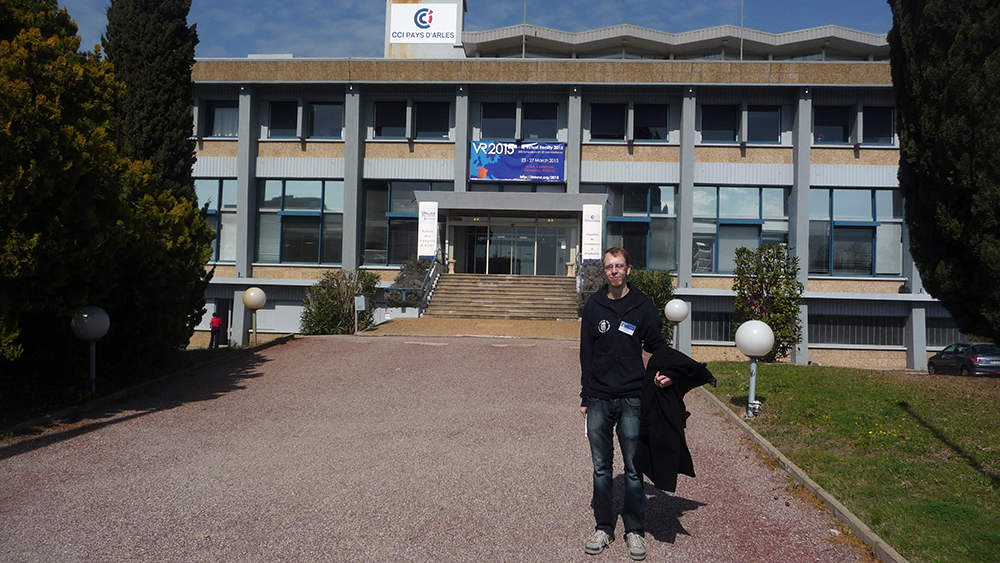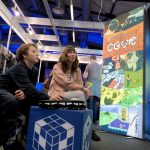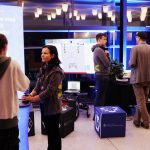By Madis Vasser
I’ve just returned from a week-long trip to Arles, France to attend IEEE VR 2015, the “premiere international conference & exhibition on VR”, held since 1993. Outside of the academic circle the event is hardly known, although it is marketed to academics, industry workers and also regular end-users. I was was there on the academic side, showing off our preliminary VREX toolbox. What follows is a first hand account of all the talks, demos and ideas that I came across.
So what does your average 21st century virtual reality lab concist of? Usually it has a mandatory CAVE (cave automatic virtual environment) that projects a virtual environment around the user on 3 to 6 walls. Then there are of course a few head-mounted displays, usually something old and expensive, as well as a few fresh Oculus kits. Full-body tracking is common, achieved with tightly calibrated optical systems. Most labs use Unity to drive their programs, or custom software. The topics generally explored are in the realms of multi-user VR, real-time rendering, human computer interaction and data visualization. Here’s a great example to help you start “thinking with portals”:
Many times during the week I found myself asking: “is our brain in touch with reality?” As much as we’d like to believe this, it isn’t always so. Take for example the phenomena of proprioceptive drift mentioned in one of the persentations. If your limbs are occluded from view, you soon lose precise tracking on the whereabouts of your body. This could be either a problem or an opportunity for VR, depends on your point of view. A good example on the phenomena is the classic rubber hand illusion, where simultaniously stroking a persons real hand and a fake replica while only seeing the fake one will results in the acceptance of the fake hand as a genuine part of the body. The keynote speech by Mel Slater focused mainly on the fact that our body image and even the sense of self is highly malleable. He presented many works on modifying body perception and agency – making the study subject believe that they inhibit a new body, or believe they speak and act while actually not doing so. Slater’s bottom line was that VR can not only transform the place, but also the self. This is something we in the CGVR lab also work closely with.
But is the current academic VR community in touch with reality? From many presentations I got the feeling that the researchers were solving problems that either do not exist or have been solved. Take for example collaborative workspaces for scientists and engineers. As one presenter summarized: “The problem is not hardware or software – it’s getting actual scientists to come into the lab and use it to visualize their data”. And another noted: “Designing CAD files is a private activity” – meaning that designers do not actually want to collaborate with each other in a virtual world, because this is in no way productive. But there were also some pressing issues discussed, like true social VR. But by the conference standards “social” VR meant 2-3 people in the CAVE. On a special panel discussion dedicated to this very topic I asked if any research groups have done or are planning to do VR studies with a large number of simlutanious participants, citing the recent news of the 100 000th Oculus DK2 being shipped. The answer was sadly no. So it appears startups like Convrge and Altspace are doing the groundwork one might have expected from academic institutions. Even though the previous generation of VR devices were big and slow, they have been around for tens of years. At least there should be a wealth of knowledge on the effect of long-term VR use. Onca again I was disappointed, as many presentations concluded with the fact that no long-term studies on the subject has been conducted. Throughout the whole week I felt a distinct “we” versus “them” vibe between the academic and the commercial VR research. I can not see this being beneficial to the field in any way. In this light it is interesting that the “technical achievement award” for 2015 was awarded to Oculus for the Rift.
In parallel with the presentations there was a research demo area where I got to try many interesting gadgets.A solution for navigation in VR was demonstrated by 3D rudder – a feet-controlled joystick to move about in the virtual world. The fidelity of the controller was good, but sadly the VR helicopter demo they showed was quite nauseating. Another interesting demo was for faking liquids in bottles – so when you tilt the bottle, it sounds and feels like liquid pouring out, except it is all a clever mechanical illusion. Slightly less impressive were vibrating sandals that matched the footsteps that occured in a recorded video, so you could “feel” your steps while watching a POV walking video. A full list of demos (incuding ours) can be found here.
One interesting, albeit limited demo was given to me in the lunch hall by Max Pfeiffer. It’s a possible solution for VR haptics, concisting of electrodes on the arm. Felt like touching a virtual electric fence!
From the many different VR lab overviews my eye was most cought by the Mixed Realities lab (MxR) in the university of Southern California, presented by Evan Suma. MxR is basically one of the birthplaces of the current wave of mobile display VR devices, doing such experiments already in 2011. Currently they are working on automatic fast character capture and redirected walking using change blindness.
Another great presentation was by the University of Hamburg VR lab, where they have done some extensive 24h VR sessions to see the effects of long-term VR use (pdf), and also experiment with the sensatsion of flying etc. So I advise keeping a keen eye on these two groups. I’d also like to mention the presentation on Substitutional Reality by Adalberto Simeone – his talk was about matching physical object in VR and replicating or replacing some object features. An umbrella reportedly works great for a light sabre. But for objects with a bigger visual and tactile mismatch the illusion weakens a lot. The question remains – can we train the brain with repeated exposure to accept the fact that a big sword can be as light as a flashlight?
All in all the conference was a huge eye opener. Mel Slater began his keynote in the lines of “Someone told me VR had been dead. I didn’t notice”. I’d say now the scene is truly alive and kicking, and I’m worried that the academic community has once again largely not noticed.
I’d like to thank the following names for making my trip possible one way or another: University of Tartu, Jaan Aru, Raul Vicente Zafra, Markus Kängsepp, Kälver Kilvits, Taavi Kivisik, Eva Pruusapuu, Psychobus.




